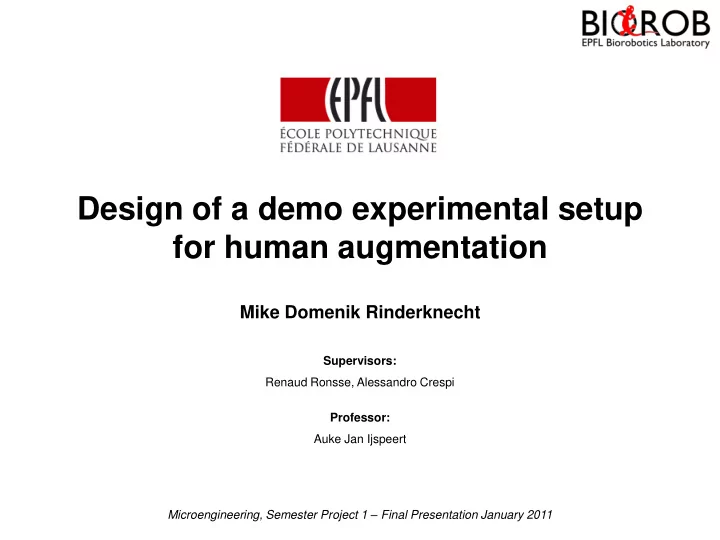

Design of a demo experimental setup for human augmentation Mike Domenik Rinderknecht Supervisors: Renaud Ronsse, Alessandro Crespi Professor: Auke Jan Ijspeert Microengineering, Semester Project 1 – Final Presentation January 2011
State of the art – Inspiration R. Ronsse et al., “Human -robot Synchrony: Flexible Assistance using Adaptive Oscillators”, Biomedical Engineering, IEEE Transactions on , 2010 January 2011 Design of a demo experimental setup for human augmentation - Mike Domenik Rinderknecht 2
Previous Semester Project F. A. Delaloye , “Series Elastic Actuator (SEA): Laboratory set up for human augmentation and assistance”, Semester Project Biorob, EPFL , June 2010 January 2011 Design of a demo experimental setup for human augmentation - Mike Domenik Rinderknecht 3
Goals of the project • Finalization of mechanical design (proper setting of SEE) • Finalization of electronics (solve voltage and current problems) • Establishment of communication EPOS MATLAB • Creation of an easy to use library with functions / blocks • Setting up an experimental protocol (perform experiments with healthy people and analyze results) + Publication on the experimental results, depending on timing and results (ICORR 2011 Zürich) + Design of a new hardware setup including mechanical torque limitation January 2011 Design of a demo experimental setup for human augmentation - Mike Domenik Rinderknecht 4
Series Elastic Element (SEE) Disk 2 deviated by ∆θ Resting position ∆θ Torque τ SEE Pin on disk 1 Pin on disk 2 Characterization Applied ┴ force at 30 cm 3 N Measured angular deviation 0.26 rad SEE spring rate 3.8 Nm/rad Torque τ SEE linear Maximal possible deviation 0.28 rad Maximal SEE torque 1.1 Nm Deviation ∆θ Very small maximal torque ! January 2011 Design of a demo experimental setup for human augmentation - Mike Domenik Rinderknecht 5
Safety – Torque limitation Problem Solutions • Motor stall torque 2500 mNm Mechanical torque limititation Gearbox reduction 126:1 Gearbox efficiency 75% Torque on elbow 236 Nm Equivalent force on forearm at 30 cm 788 N Equivalent mass for horizontal forearm 80 kg Total disengagement at 15 Nm Admissible torque for the elbo w ~ 15 Nm ! • Motor current limitation Torque constant 60.3 mNm Maximal motor current 2.63 A Torque limitation at 15 Nm January 2011 Design of a demo experimental setup for human augmentation - Mike Domenik Rinderknecht 6
New device Goal: safe, flexible and simple design Housing for electronics Standard Y-bearing plummer block units Space for motor + gearbox January 2011 Design of a demo experimental setup for human augmentation - Mike Domenik Rinderknecht 7
New device Large space for new SEE design Goal: safe, flexible and simple design Space for mechanical torque limiter Various configurations possible January 2011 Design of a demo experimental setup for human augmentation - Mike Domenik Rinderknecht 8
Electronics January 2011 Design of a demo experimental setup for human augmentation - Mike Domenik Rinderknecht 9
Electronics January 2011 Design of a demo experimental setup for human augmentation - Mike Domenik Rinderknecht 10
Communication EPOS – MATLAB – Simulink USB Definitions.h EposCmd.dll DLL, Header file load to MATLAB library_dll.m library_epos.m MATLAB m-files class_epos.m MATLAB class Library of Simulink Blocks with MATLAB Level-2 S-Functions simulink_epos_library.mdl January 2011 Design of a demo experimental setup for human augmentation - Mike Domenik Rinderknecht 11
Simulink rehab library MATLAB Level-2 S-Function Embedded MATLAB Functions Embedded MATLAB Functions Embedded MATLAB Functions Function Blocks simulink_rehab_library.mdl January 2011 Design of a demo experimental setup for human augmentation - Mike Domenik Rinderknecht 12
Simulink example January 2011 Design of a demo experimental setup for human augmentation - Mike Domenik Rinderknecht 13
Experiments – Simulink model January 2011 Design of a demo experimental setup for human augmentation - Mike Domenik Rinderknecht 14
Experiments – Predictions Frequency variations of a representative participant as a function of estimation errors • Overestimating equivalent length Smaller movement frequency, and vice-versa • Overestimating inertia Larger movement frequency, and vice-versa • Overestimating damping coefficient Slightly larger movement frequency, and vice-versa January 2011 Design of a demo experimental setup for human augmentation - Mike Domenik Rinderknecht 15
Experiments – Results Frequency evolution of a representative participant during the different configurations Steady state frequencies of a representative participant January 2011 Design of a demo experimental setup for human augmentation - Mike Domenik Rinderknecht 16
Experiments – Results Wilcoxon rank-sum test on the frequencies 39 of 45 tests (87%) correspond to the predictions, confidence levels > 99.9% Sensitivity e.g. for the length: January 2011 Design of a demo experimental setup for human augmentation - Mike Domenik Rinderknecht 17
Experiments – Publication M. D. Rinderknecht, F. A. Delaloye, A. Crespi, R. Ronsse and A. J. Ijspeert, “ Assistance using adaptive oscillators: Sensitivity analysis on the resonance frequency ” January 2011 Design of a demo experimental setup for human augmentation - Mike Domenik Rinderknecht 18
Future work • Iteration on SEE design, develop a new solution • Accurate system identification of the new device to integrate a correct dynamical model into the control • Further experiments with people January 2011 Design of a demo experimental setup for human augmentation - Mike Domenik Rinderknecht 19
Questions Thank you for your attention. January 2011 Design of a demo experimental setup for human augmentation - Mike Domenik Rinderknecht 20
Recommend
More recommend